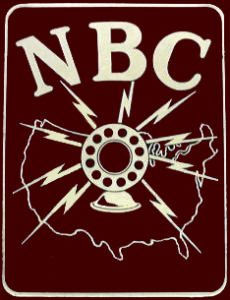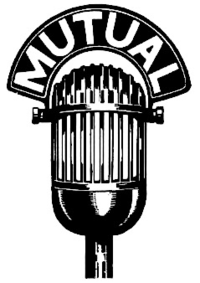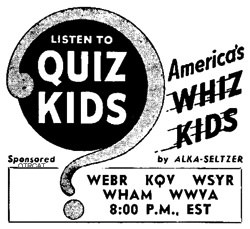 If there is one thing we all realize when and if we study the cartoons that we saw, either in the theaters or on television, it’s that they relied on topical humor for some, if not many, of the laughs they got from their original audiences.
If there is one thing we all realize when and if we study the cartoons that we saw, either in the theaters or on television, it’s that they relied on topical humor for some, if not many, of the laughs they got from their original audiences.
As the generations roll on, what was “topical” becomes “dated’ on its way to becoming “nostalgia”. Eventually, it becomes a sort of potted history of its time, as if it were preserved in amber, waiting for archaeologists to come along and figure out what it meant, and why its audience found it to be funny or endearing.
By the time that game shows–also known as “quiz shows” and (in the trade) “audience-participation shows”–became a staple of network radio (we’re talking the late 1930’s), the various animation studios–Disney, Warner Bros., M-G-M, Lantz, Fleischer, Terrytoons and Mintz being the largest–they were all smoothly-running suppliers of animated cartoons to the major studios.
 And, as the humor in these cartoons was so often topical, it figures that there would be cartoons inspired by the game shows of the time. Formats and catch-phrases were fair game to the cartoon writers, directors and artists.
And, as the humor in these cartoons was so often topical, it figures that there would be cartoons inspired by the game shows of the time. Formats and catch-phrases were fair game to the cartoon writers, directors and artists.
Neither Disney, nor M-G-M, nor Terrytoons touched upon the subject. Nor did these three animation houses try to find gag material in the giveaway shows of the day.
But, a various times, other studios did find game shows to be fair game for their barbs. Sometimes, there would be a single gag in a larger cartoon context. At other ties, the entire cartoon, or a goodly part of it, would take off on a particular game show, or some aspect of the format.
This is the first of a several posts examining the connection between quiz shows (later known as “game shows) and Hollywood cartoon shorts. We’ll start out, not with the biggest of the big boys, but with a couple of cartoons from a studio whose product is still obscure to many animation fans: Columbia/Screen Gems.
 The Cuckoo I. Q. (1941) is trying to be a takeoff on “Quiz Kids”, an early success in the game-show field. However, the story does not seem to want to get too close to its subject.
The Cuckoo I. Q. (1941) is trying to be a takeoff on “Quiz Kids”, an early success in the game-show field. However, the story does not seem to want to get too close to its subject.
On “Quiz Kids”, a panel of kids, form six- to fifteen-years old, would field questions sent in by listeners at home, who hoped to stump these little geniuses.
This cartoon does capture the idea that the show’s host is no mental marvel himself. Instead of going for cornfed Joe Kelly (brought over from “National Barn Dance”) this cartoon goes for a downmarket New York voice (Mel Blanc) for its host — Brooklyn, or the Lower East Side of Manhattan, say.
Although Sid Marcus tries hard in his direction, the script proves repetitive, with the moronic contestant getting continually pummeled for wrong answers.
AUDIO BONUS: Thanks to reader David Pomerantz we present a 1941 Quiz Kids show broadcast from Disney studios. Partially scripted, departing from their usual format, it seems to be a promotion for The Reluctant Dragon – as they look at boards for Baby Weems (and as you’ll recall their is a reference to the Quiz Kids in that segment). Who do suppose is doing the voice of Goofy at 10:10?
The Herring Murder Mystery (1944) — not to be confused with The Herring Murder Case, a 1932 Max Fleischer Tallkartoon involving Bimbo and Ko-Ko the Clown–is closer in its parody of a particular game show. It’s a few other things, too–including, in part, an early example of a “noir” cartoon, before the feature films of that description really got going.
 From the opening scenes,you would not think that they were going to be making fun of anything except the moody murder mysteries that would eventually be called “film noir” , first by French film critics, then by film buffs in general. When it veers off–as it does–it comes as a surprise.
From the opening scenes,you would not think that they were going to be making fun of anything except the moody murder mysteries that would eventually be called “film noir” , first by French film critics, then by film buffs in general. When it veers off–as it does–it comes as a surprise.
When our hero–a mousy little guy who makes his living by dipping live herring into a barrel of vinegar, then canning them as “Marinated Herring”–finds himself in a nightmare scenario at the bottom of the sea (on trial for his life, with judge, jury, witnesses and attorneys all being fish)–then the script veers into a parody of “Information Please”.
“Information Please” was the grand-daddy of all “panel quiz” programs, both on radio and television. The panel consisted of several experts who were both intelligent and witty. The witty nature of the panel,which included newspaper columnists and a concert pianist, made the show a favorite with intellectuals, and with those who appreciated a well=turned pun.
This was also the first of the “beat the experts” type of game shows. People from all over the country submitted questions which would be posed to panel. And if the question stumped the panel, then the nice folks at home won a modest cash prize–and a set of the Encyclopaedia Brittannica–not a bad prize then, or now! (There would be a smaller cash prize if the question was used and answered by the panel.)
The script manages to ring the changes on many of the tropes of the show, including the encyclopedia and the puns, some of which would not have been out of place in a Famous Studios cartoon of several years later. Another trope that got aired out was that one of the panelists (Franklin P. Adams) was a nut on baseball trivia, and woud drop it in at the fall of a hat–oops,there go the chapeau!
The ending of the short is a trifle weak. And it’s no wonder that even the piscatorial analogue to Clifton Fadiman would want to get away from the deliberately annoying “Something on the end of the hook” refrain that runs through this cartoon
But is does seem typical of the average run of Columbia cartoons of this period.
Next: At bat at Termite Terrace.
Editors Note: All comments to this article should address the content of this particular post. Please do not send in lists of all the “Quiz Show” cartoons you can think of – they will be addressed in subsequent posts in forthcoming weeks.


 James Parten has overcome a congenital visual disability to be acknowledged as an expert on the early history of recorded sound. He has a Broadcasting Certificate (Radio Option) from Los Angeles Valley College, class of 1999. He has also been a fan of animated cartoons since childhood.
James Parten has overcome a congenital visual disability to be acknowledged as an expert on the early history of recorded sound. He has a Broadcasting Certificate (Radio Option) from Los Angeles Valley College, class of 1999. He has also been a fan of animated cartoons since childhood.











































In my view, with regard to “Herring Murder Mystery,” the fish that does the baseball bit looks a lot more like an Oscar Levant caricature than it does F.P.A., who had a very notable pointed honker (F.P.A. is the figure on the middle right in the Mobil ad you post); this, in spite of the fact that Levant was not (as you correctly say) the baseball “bug” on the panel. The first fish, the one does the “disturbing the peace” line, looks more like John Kieran (who was a New York Times sportswriter); he’s the bottom right figure at the top of the Mobil ad.
It’s a pity available prints chop the musical gag; that was one of Levant’s specialties, naturally, on the show, and there’s a hint the Levant caricature (or what I believe to be the Levant caricature) has a line that gets obscured.
I’ve seen references to the “hero” being called “Puzzlewicz” (i.e., puzzlewits).
You can also compare this against a rarish film of “Information, Please!” done as a short for RKO, which you can find here: https://www.youtube.com/watch?v=TXIvTqvhjTI Levant is introduced at 1:20, F.P.A. at 1.28 and Kieran at 1.32. This is one of the bases for my identifications of the caricatures, noted above. At 8.25 ff., you’ll see a demonstration of the musical question format, which is spoofed in the cartoon.
I know others have mentioned this in previous posts: “The Cuckoo IQ” was a parody of “Dr. IQ,” known for the phrase “I have a lady in the balcony” (the show’s announcer, George Ansbro, made that the title of his autobiography).
I always wanted to ask this: why was the story department at Columbia so unbelievably disorganized both before and after Tashlin was at the studio?
Donald Duck was an especially attentive radio listener (CHEF DONALD, THE PLASTICS INVENTOR, THE NEW SPIRIT, DUCK PIMPLES, SLIDE DONALD SLIDE … Did I miss any?). Surprised they never had him listening to and calling in for a quiz show.
That is pretty interesting to mention. One I can think of is “Donald Duck and the Gorilla” with him and the nephews listening along to a radio report on an escape gorilla. In a later cartoon,” Lucky Number”, Donald listens to a radio drawing, hoping he had the winning number to win a car.
Not in the cartoons, maybe, but he did go crazy a couple of times in the comics, this time for TV quiz shows. He is frustrated that he can’t get on a quiz show despite knowing all the answers (and growing more and more frenzied as the contestant misses them). Donald tries to get on one particular show with a stupid pet trick (not their term). He is beaten out by his own nephews. The host asks them, “What is a three-letter word for an animal that catches mice?”
“A cat! A CAT!” screams Donald at home.
“An owl,” say the nephews. Too clever, kids. It was a cat.